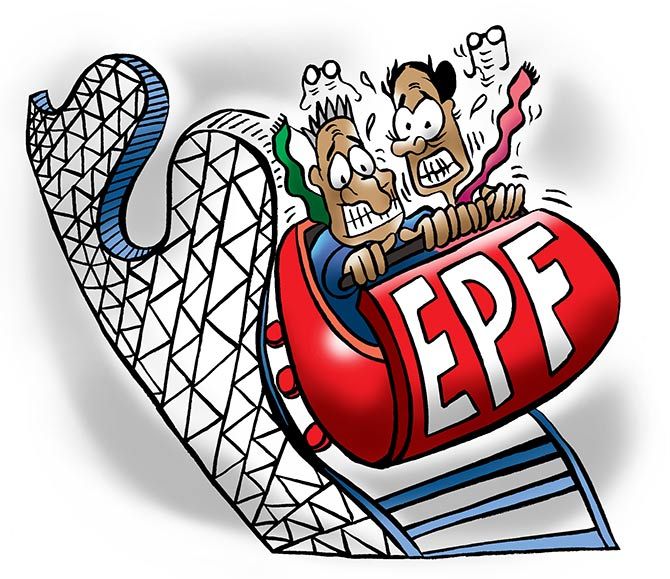'How is the scheme running despite running such massive deficits?'
'This is because the number of new members are much more than earlier members who are drawing pension.'
'If this was done by a private organisation, it would have been called a Ponzi scheme in which the contribution by new members is being used to pay off old members,' says Harsh Roongta.
Illustration: Uttam Ghosh/Rediff.com

Have you been a salaried employee for at least 10 years? If the answer is yes, you and your spouse are most likely to be eligible for a lifelong pension from the Employee Provident Fund Office (EPFO).
I will not blame you if you are not even aware about this eligibility.
For one, you cannot get it till you reach the age of 58 years.
Second, for most middle-class households, the amount would be a pittance as it ranges from Rs 1,000 to Rs 7,500 a month. And it will be fixed for the entire lifetime.
Since most are not even aware of this eligibility, it would surprise them to know that this scheme is running a deficit of approximately at Rs 1.25 trillion. That's right.
There is very little data available on the deficit run up by the EPS. However, I chanced upon a valuation report as on March 31, 2009 (the report is dated February 25, 2013).
This is by an expert appointed by the EPFO who has estimated that it will require a one-time contribution of around Rs 620 billion to make good the deficit on March 31, 2009.
In 2008, this deficit was Rs 540 billion.
So, in a single year, the deficit grew Rs 75 billion.
Assuming the same run since then for nine years and we are staring at large number like Rs 1.25 trillion.
There are other interesting aspects in the valuation report.
One, the EPFO was unable to provide vital data such as date of birth, date of joining, salary, etc for around 95 per cent of their members.
They had 78 per cent data for employees who are already getting this benefit.
The worst: The EPFO seems to have no clue on how many people have quit their jobs after 10 years and hold certificates to receive pension after they reach the age of 58 years.
The valuer, consequently, mentions that the EPFO has asked him to get on with the valuation report 'despite the data constraints'.
Unfortunately, the bad news does not stop here.
A 2016 Supreme Court's decision is reported to have removed the maximum ceiling on the pension and it has already led to a manifold increase in the pension liability for those employees who opt for it.
Its impact on the already burgeoning deficit is unknown but the increase in deficit will be in multiples of the existing deficit should all employees opt for the increase.
How is the scheme running despite running such massive deficits?
This is because the number of new members are much more than earlier members who are drawing pension.
So, despite the low contributions, it is still enough to pay for the current narrow base of pensioners drawing the pension.
If this was done by a private organisation, it would have been called a Ponzi scheme in which the contribution by the new members is being used to pay off the old members.
Another saving grace has been the low awareness about the EPS itself.
Most people are completely unaware about this scheme and let their eligibility lapse.
This, thankfully, is a boon in disguise for this ailing scheme.
Harsh Roongta is a Sebi-registered investment advisor.










